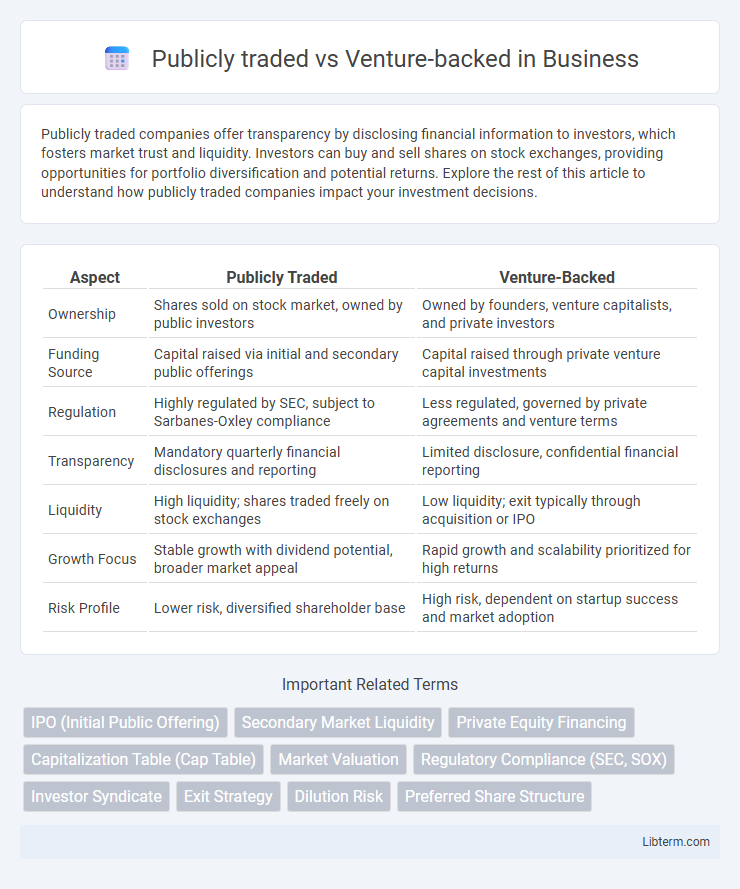Publicly traded companies offer transparency by disclosing financial information to investors, which fosters market trust and liquidity. Investors can buy and sell shares on stock exchanges, providing opportunities for portfolio diversification and potential returns. Explore the rest of this article to understand how publicly traded companies impact your investment decisions.
Table of Comparison
| Aspect | Publicly Traded | Venture-Backed |
|---|---|---|
| Ownership | Shares sold on stock market, owned by public investors | Owned by founders, venture capitalists, and private investors |
| Funding Source | Capital raised via initial and secondary public offerings | Capital raised through private venture capital investments |
| Regulation | Highly regulated by SEC, subject to Sarbanes-Oxley compliance | Less regulated, governed by private agreements and venture terms |
| Transparency | Mandatory quarterly financial disclosures and reporting | Limited disclosure, confidential financial reporting |
| Liquidity | High liquidity; shares traded freely on stock exchanges | Low liquidity; exit typically through acquisition or IPO |
| Growth Focus | Stable growth with dividend potential, broader market appeal | Rapid growth and scalability prioritized for high returns |
| Risk Profile | Lower risk, diversified shareholder base | High risk, dependent on startup success and market adoption |
Introduction to Publicly Traded and Venture-Backed Companies
Publicly traded companies offer shares on stock exchanges, allowing investors to buy and sell ownership stakes, providing liquidity and access to capital from the general public. Venture-backed companies secure funding from venture capital firms during early growth stages, focusing on rapid expansion and innovation without immediate public market scrutiny. Each structure impacts regulatory requirements, growth strategies, and investor expectations, shaping business operations and financial dynamics.
Key Differences in Ownership Structure
Publicly traded companies have ownership distributed among numerous shareholders through the stock market, allowing public investors to buy and sell shares freely. Venture-backed companies typically have concentrated ownership among founders, venture capitalists, and early employees, with shares usually not available to the general public. This difference in ownership structure impacts control, decision-making, and regulatory requirements for each type of company.
Funding Sources and Capital Access
Publicly traded companies access capital primarily through equity markets by issuing shares to a broad base of investors, enabling them to raise substantial funds from public stock exchanges. Venture-backed startups rely on private funding from venture capital firms, which provide early-stage financing in exchange for equity stakes, often bringing strategic guidance alongside capital. While public companies benefit from liquidity and transparent valuation, venture-backed firms gain focused investment and growth-oriented support but face limited public funding channels.
Growth Strategies and Scalability
Publicly traded companies leverage capital markets to access vast funding for large-scale growth initiatives and global expansion, driving rapid scalability through shareholder investments. Venture-backed startups utilize targeted venture capital to fuel innovative product development and market penetration, prioritizing agile, high-growth strategies with scalable business models. Both growth strategies emphasize scalability, but publicly traded firms rely on established infrastructures for sustained expansion, while venture-backed companies focus on disruptive innovation to capture market share quickly.
Regulatory and Compliance Requirements
Publicly traded companies must comply with extensive regulatory frameworks such as the Sarbanes-Oxley Act, SEC filing requirements, and mandatory financial disclosures to ensure transparency and protect shareholders. Venture-backed startups face comparatively lighter regulatory scrutiny but must adhere to securities laws during funding rounds and maintain governance protocols to satisfy investor agreements. Both structures require ongoing compliance, though publicly traded firms encounter more rigorous reporting and audit obligations to meet market and regulatory standards.
Investor Expectations and Influence
Publicly traded companies face investor expectations centered on consistent quarterly earnings, market transparency, and regulatory compliance, with shareholders exerting influence through voting rights and market pressures. Venture-backed startups attract investors prioritizing rapid growth, innovation milestones, and eventual exit strategies like IPOs or acquisitions, with venture capitalists often holding significant control and strategic input. These differing investor profiles shape corporate governance, decision-making speed, and risk tolerance in each funding model.
Liquidity and Exit Opportunities
Publicly traded companies provide high liquidity through stock exchanges, enabling investors to buy and sell shares easily with transparent pricing. Venture-backed startups typically offer limited liquidity, as shares are not publicly traded and exit opportunities depend largely on acquisition or initial public offering (IPO) events. Exit opportunities in venture-backed firms can yield substantial returns but are less predictable compared to the steady liquidity of public markets.
Valuation Methods and Market Perception
Valuation methods for publicly traded companies primarily rely on market capitalization, determined by multiplying the current stock price by the total outstanding shares, reflecting real-time investor sentiment and liquidity. Venture-backed startups, on the other hand, use funding rounds and comparable company analysis, emphasizing projected growth and revenue potential rather than established financial performance. Market perception of publicly traded firms centers on transparency, regulatory compliance, and quarterly earnings reports, whereas venture-backed firms are valued for innovation, scalability, and disruptive potential despite higher risk and less liquidity.
Risks and Challenges for Each Model
Publicly traded companies face risks such as stock market volatility, regulatory compliance costs, and shareholder pressure for short-term performance, which can limit long-term strategic initiatives. Venture-backed startups encounter challenges including dependence on continuous funding rounds, high burn rates, and potential dilution of ownership, coupled with the pressure to achieve rapid growth and scalability. Both models demand rigorous risk management, but publicly traded firms prioritize market stability, while venture-backed businesses focus on innovation and capital efficiency.
Choosing the Right Path for Your Business
Choosing between publicly traded and venture-backed funding depends on your company's growth stage, capital needs, and control preferences. Publicly traded companies benefit from broad capital access and liquidity but face rigorous regulatory requirements and shareholder pressures. Venture-backed startups receive strategic support and accelerated funding, though founders often relinquish equity and decision-making control during early growth phases.
Publicly traded Infographic

 libterm.com
libterm.com